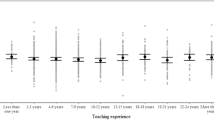Abstract
In this paper a part of the data from a larger study, the Enactment Project, is explored. The exploration is guided by two research questions. The first is specific to the instructional core of teacher practice while the second is related to student perceptions of how they learn mathematics. The project adopted the Complementary Accounts Methodology. Micro-analysis of how three teachers enacted their instructional objectives, using qualitative data analysis methods, led to the identification of three components of an instructional core, namely, Development of concepts and skills [D], Student work [S] and Review of student work [R] that pervade the lessons of the three teachers. They enacted their instructional objectives through instructional cycles comprising combinations of D, S, and R. A lesson was found to comprise one or more instructional cycles. The post-lesson video-stimulated student interview data, showed that teachers helped their students learn mathematics in their lessons specifically in the S and R activity segments. This paper also dispels the myth about stereotypical mathematics instruction in Asian classrooms whilst contributing to this issue of ZDM in memory of David Clarke. It was his work related to the Complementary Accounts Methodology that provided colleagues in Singapore with a tool to illuminate mathematics instruction in their schools.



Similar content being viewed by others
References
Anthony, G., & Walshaw, M. (2007). Effective pedagogy in mathematics: Best evidence synthesis iteration [BES]. Ministry of Education.
Anthony, G., Kaur, B., Ohtani, M. & Clarke, D. (2013). The Learner's Perspective Study: Attending to student voice. In B. Kaur, G. Anthony, M. Ohtani & D. Clarke (Eds.), Student voice in mathematics classrooms around the world (pp. 1–11). Sense Publishers.
Biggs, J., & Watkins, D. (2001). Teaching the Chinese learner: Psychological and pedagogical perspectives. The University of Hong Kong, Comparative Education Research Centre.
City, E. A., Elmore, R. F., Fiarman, S. E., & Teitel, L. (2009). Instructional rounds in education: A network approach to improving teaching and learning. Harvard Education Press.
Clarke, D. J. (1998). Studying the classroom negotiation of meaning: Complementary accounts methodology, chapter 7. In A. Teppo (Ed.), Qualitative research methods in mathematics education, monograph number 9 of the Journal for Research in Mathematics Education (pp. 98–111). NCTN.
Clarke, D. (2006). The LPS research design. In D. J. Clarke, C. Keitel, & Y. Shimizu (Eds.), Mathematics classrooms in twelve countries: The insider’s perspective (pp. 15–36). Sense Publishers.
Clarke, D. J., Keitel, C., & Shimizu, Y. (2006). The learner’s perspective study. In D. J. Clarke, C. Keitel, & Y. Shimizu (Eds.), Mathematics classrooms in twelve countries: The insider’s perspective (pp. 1–14). Sense Publishers.
Doyle, W. (1983). Academic work. Review of Educational Research, 53(2), 159–199.
Glaser, B., & Strauss, A. (1967). The discovery of grounded theory. Aldine.
Hogan, D., Chan, M., Rahim, R., Kwek, D., Aye, K. M., Loo, S. C., Sheng, Y. Z., & Luo, W. (2013). Assessment and the logic of instructional practice in secondary three English and mathematics classrooms in Singapore. Review of Education, 1, 57–106.
Kaur, B. (2009). Characteristics of good mathematics teaching in Singapore grade 8 classrooms: A juxtaposition of teachers’ practice and students’ perceptions. ZDM - the International Journal on Mathematics Education, 41, 333–347.
Kaur, B., Anthony, G., Ohtani, M., & Clarke, D. (Eds.). (2013). Student voice in mathematics classrooms around the world. Sense Publishers.
Kaur, B., & Loh, H. K. (2009). Student perspective on effective mathematics pedagogy: Stimulated recall approach study. National Institute of Education.
Kaur, B., Tay, E. G., Toh, T. L., Leong, Y. H., & Lee, N. H. (2018). A study of school mathematics curriculum enacted by competent teachers in Singapore secondary schools. Mathematics Education Research Journal, 30(1), 103–116.
Lee, N. H., Kaur, B., & Safii, L. (2021). The enacted curriculum—students’ perspectives of good mathematics lessons in Singapore secondary schools. In B. Kaur & Y. H. Leong (Eds.), Mathematics instructional practices in Singapore secondary schools (pp. 183–201). Springer Nature.
Lee, N. H., & Safii, L. (2021). Teaching practices that promote mastery in mathematics learning in Singapore secondary school classrooms. In B. Kaur & Y. H. Leong (Eds.), Mathematics instructional practices in Singapore secondary schools (pp. 79–103). Springer Nature.
Leung, F. K. S. (2001). In search of an East Asian identity in mathematics education. Educational Studies in Mathematics, 47(1), 35–41.
Leung, F. (2006). Mathematics education in East Asia and the West: Does culture matter? In F. Leung, K.-D. Graf, & F. Lopez-Real (Eds.), Mathematics education in different cultural traditions: A comparative study of East Asia and the West (pp. 21–46). New York: Springer.
National Research Council. (2001). Adding it up: Helping children learn mathematics. Report prepared by the Mathematics Learning Study Committee. National Academy Press.
Shimizu, Y. (2002). Capturing the structure of Japanese mathematics lessons: Some findings of the international comparative studies. In Paper presented at the ICMI-Second East Asia Regional Conference on Mathematics Education and Ninth Southeast Asian Conference on Mathematics Education. National Institute of Education
Sinclair, J., & Coulthard, M. (1992). Towards an analysis of discourse. In M. Coulthard (Ed.), Advances in spoken discourse analysis (pp. 1–34). Routledge.
Stigler, J. W., & Hiebert, J. (1997). Understanding and improving mathematics instruction. Phi Delta Kappan, 79(1), 14–21.
Stodolsky, S. S. (1988). The subject matters: Classroom activity in math and social studies. The University of Chicago Press.
Wenger, E. (1998). Communities of practice: Learning, meaning and identity. Cambridge University Press.
Funding
Funding was provided by Office of Education Research, National Institute of Education, Singapore.
Author information
Authors and Affiliations
Corresponding author
Additional information
Publisher's Note
Springer Nature remains neutral with regard to jurisdictional claims in published maps and institutional affiliations.
Rights and permissions
About this article
Cite this article
Kaur, B. Mathematics teacher practice and student perception of how they learn mathematics in the context of Singapore. ZDM Mathematics Education 54, 387–402 (2022). https://doi.org/10.1007/s11858-021-01318-2
Accepted:
Published:
Issue Date:
DOI: https://doi.org/10.1007/s11858-021-01318-2




